For what is called the World’s Championship Bar-B-Que cook off, the event at the Houston Livestock Show and Rodeo (HSLR) is more spectacle than barbecue holy grail. Most of the quarter million visitors look longingly into private parties from the wrong side of the ropes. There’s a public food tent called the Chuck Wagon where visitors can get a complimentary chopped brisket sandwich, and a few vendors are set up around the park, but these would be meals of defeat for those not able to sweet-talk, sneak, or flirt their way into one of those flashy tents. Even those that have the right wristbands will likely get merely passable barbecue smoked in huge batches – a far cry from world championship level. The real draw is the free liquor and the metal tubs brimming with cold cans of light beer (those on the wrong side of the fence have to shell out $4 for a can of Miller Lite).
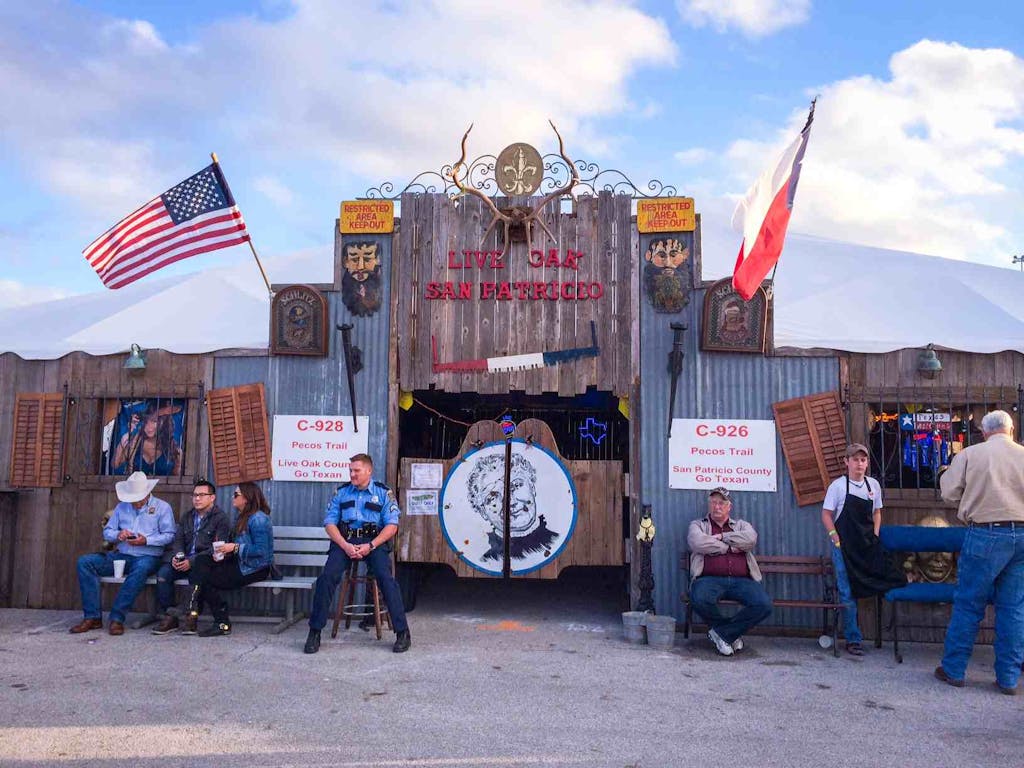
To be fair, there are a few vendors interested in winning this competition. The contest takes place between roughly 250 teams (there are 424 total entries). Most are here to enjoy the three-day party, but there are a few teams that would rather not bounce to the pulsing beats of DJ Hish on Reliant Stadium’s Miller Lite stage. These were the men and women who could find a way to work “flavor profile” into any conversation. The common consensus was that there were around thirty such teams that really had their sights set on the Grand Champion prize.
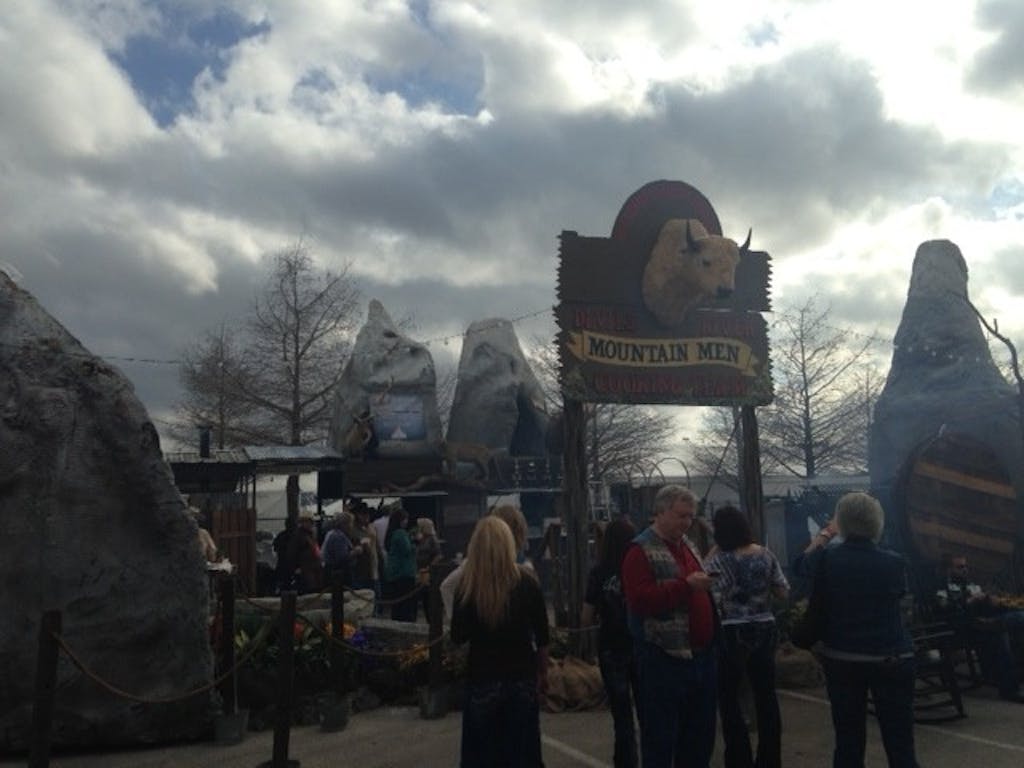
The Devil’s River Mountain Men Cooking Team covered several parking spaces and seemed like a microcosm of the HLSR pageantry. A functioning watermill was used to turn a whole hog splayed out on a grate, its skin being scorched black by a roaring fire beneath. Taxidermy representing an entire genus was mounted to a manufactured mountainscape, which served as the backdrop. I passed by the scene with Tuffy Stone, a barbecue champion many times over and celebrity judge on the BBQ Pitmasters television show, on our way to his sparse and unadorned tent in the Champions Corner, He pointed to the hog and chuckled. “It looks pretty, but I doubt it’s going taste any good” he offered. Cooking meat over an open flame, especially for a long period of time, doesn’t generally do much more than burn it, but it sure looks cool.
I say Tuffy Stone is a barbecue champion, but that doesn’t quite cover it. His Cool Smoke cooking team is the hottest in the country. They closed out 2013 by winning the American Royal Invitational and the Jack Daniel’s World Championship (aka The Jack) back-to-back. In the barbecue world, that’s like winning the Super Bowl and the World Series in the same year. Tuffy Stone did it in the same month.
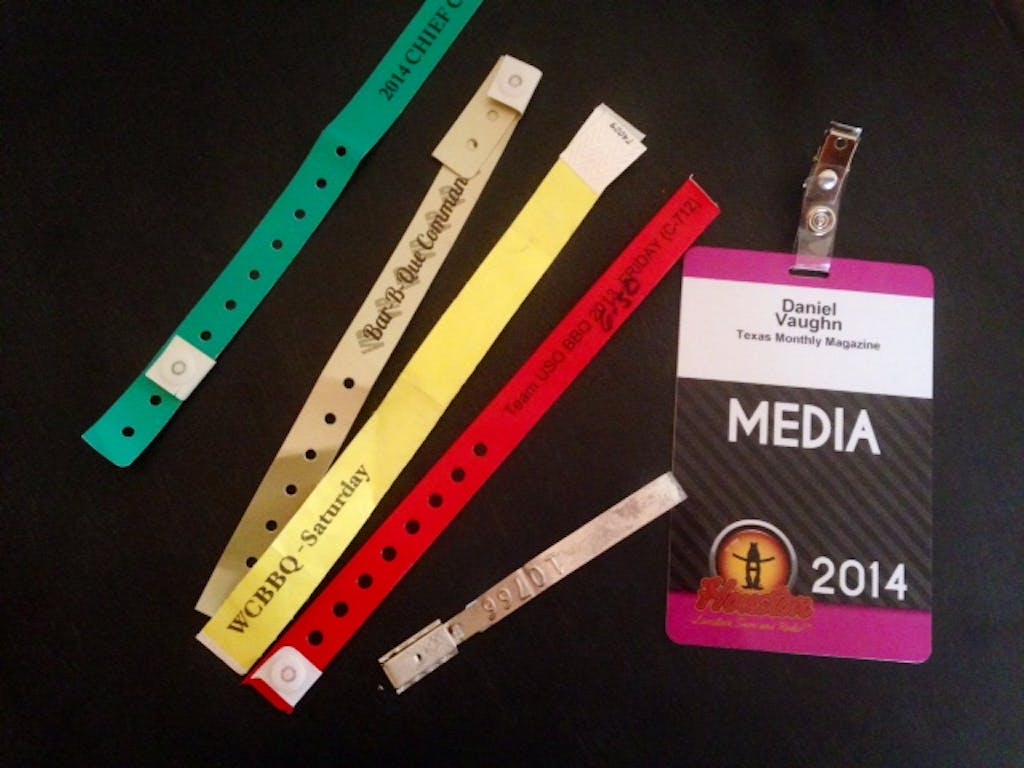
If the HLSR had a class system, I was traveling with the aristocracy. Tuffy Stone and fellow barbecue champions Johnny Trigg and Jamie Geer all invited me to watch them cook in their respective tents throughout the weekend. These three men weren’t here to party, but to win. Trigg and his talents are so highly regarded that breakfast was delivered to him and teammate-for-the-weekend Rod Gray by former HLSR Grand Champion Randy Pauly. He’s the man behind Holy Cow Cookers and is the gatekeeper to one of the most coveted parties at the HSLR under his enormous tent. Just the fact that I was sitting with Trigg got me a Holy Cow pass (but almost better, it landed me a hot biscuit with peppered bacon). Meanwhile, conversations with Tuffy Stone were routinely interrupted by fence hangers wanting a photo with the Professor of Barbecue. Geer was in demand for other reasons. As the designer and builder of the popular Jambo competition barbecue pits, folks wanted to know the length of the current waiting list. These days you’ll have to wait for months before the metallic showroom finish is applied to your Jambo smoker. Tuffy, on the other hand, just has to ask nicely.
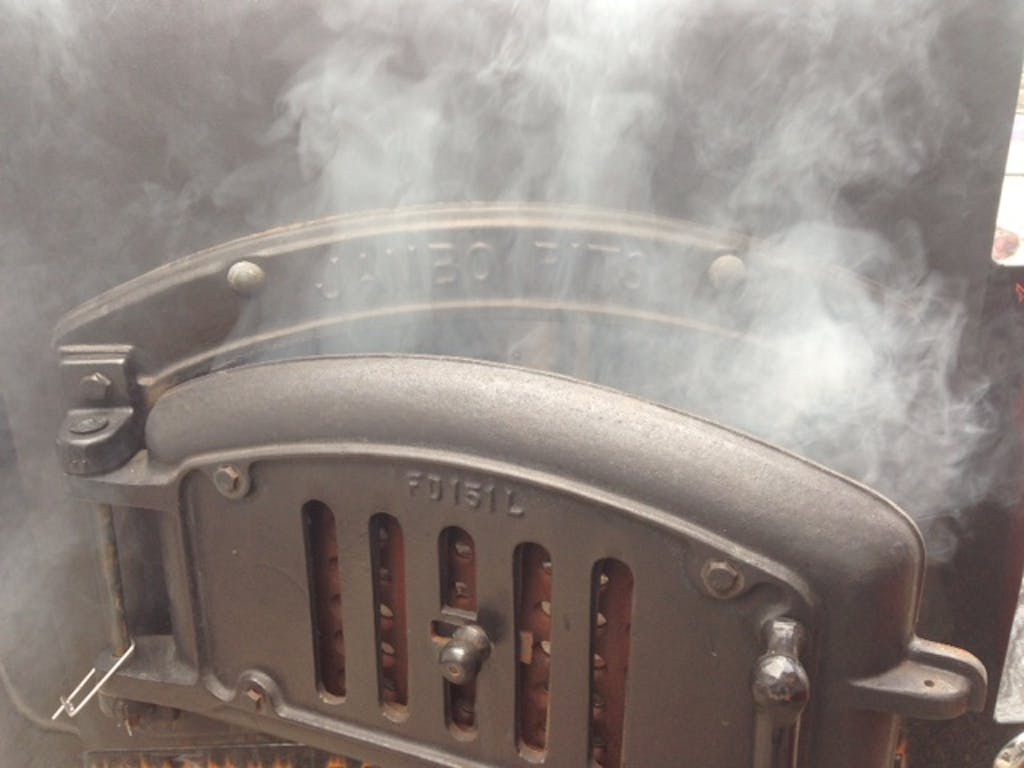
Tuffy needed a pit in Houston, so Jamie Geer let him borrow one. It was a nice gesture, but it also meant that Tuffy wouldn’t be using his regular cooker for his first competition in Texas. He was also without his RV whose interior has been retrofitted as a sort of competition barbecue battle station. A folding table and a few folding chairs would have to serve as stand-ins. A tub of vegetables for his chicken brine sat on the table. He had to wash them in his hotel sink the previous night. Next to the table were taped up boxes of firewood that had been shipped from his home in Virginia. Those boxes and the creases on his jeans from the hot iron of the hotel’s laundry service were a reminder of just how much time Tuffy has been spending on the road in search of barbecue glory. A phone call to his wife had the tone of a weary traveler just wanting to get back home. Why he was even here was a mystery to me. There was no prize money to be won. Instead, the winner got invitations to compete in the most prestigious barbecue competitions across the country, the American Royal, The Jack Daniel’s World Championship, and the Kingsford Invitational. Given Tuffy’s success in 2013, he was already invited to every one of them. He literally had nothing to win but a belt buckle, but he was focused on winning a grand championship in Texas. “I’m just a pork boy from Virginia coming down here to Brisketville” he told me with a wink.
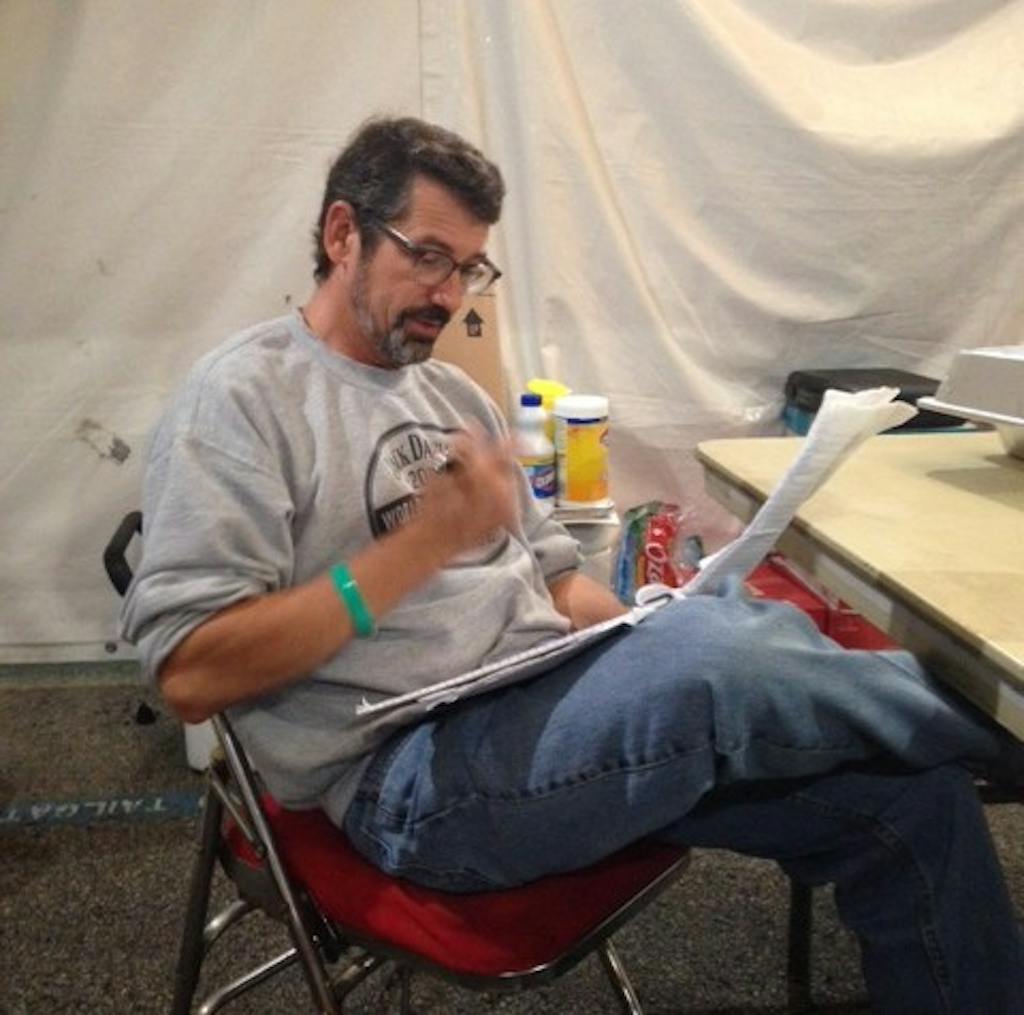
On Friday afternoon, the day before the competition, Tuffy sat at the table eating a Whataburger and writing furiously on a notepad trying to get his cooking timeline worked out. He murmured to himself about the day’s schedule, but I could hear “season chicken” and “season brisket.” Then in exasperation, “this is just so convoluted.” Then he started from the top and repeated it back to himself. The rules in Houston were different than the familiar requirements of the Kansas City Barbeque Society (KCBS) that Tuffy is so accustomed to. At least he had his regular cooking companion, his father, George Stone. Even that partnership nearly ended after a folding chair collapsed while George was using it to help him reach a light bulb, but he dusted himself off and put another log on the fire.
KCBS is the biggest sanctioning body for barbecue competitions in the U.S. Most competitors, especially those outside of Texas, cook under the same KCBS rules every weekend. Turn-in times are every half hour beginning at noon. Turn-in boxes are meticulously filled with green leaf lettuce and parsley, and the sameness of the meats makes it seem as if enough candy apple red, boneless chicken thighs had been cloned for everyone to use. That’s not the case in Houston at the World’s Championship Bar-B-Que. “No garnish is allowed” is the only item in the barbecue portion of the rulebook that is in bold. Turn-in times vary from team to team, and when they say chicken, they mean an entire half chicken.
As Friday evening drew near the prep work was completed. The Saddle Tramps team run by Steve and Janet Downey had invited me to come by their tent. They were preparing to feed racks and racks of spare ribs to a big crowd of supporters in an hour. The night before it had been steaks. They were kind enough to bring me some ribs to munch on, but the bigger impression was made by the seafood sausage. Crawfish, pork and Cajun seasoning were ground together to form a link that tasted like a smoky version of a crawfish boil. It was incredible. With a full mouth I asked them if they get sick of barbecue throughout the weekend. They laughed and Steve said that the night previous, the family had downed forty Jack-in-the-Box tacos at the hotel after the steak dinner. I think I would have chosen the seafood sausage.
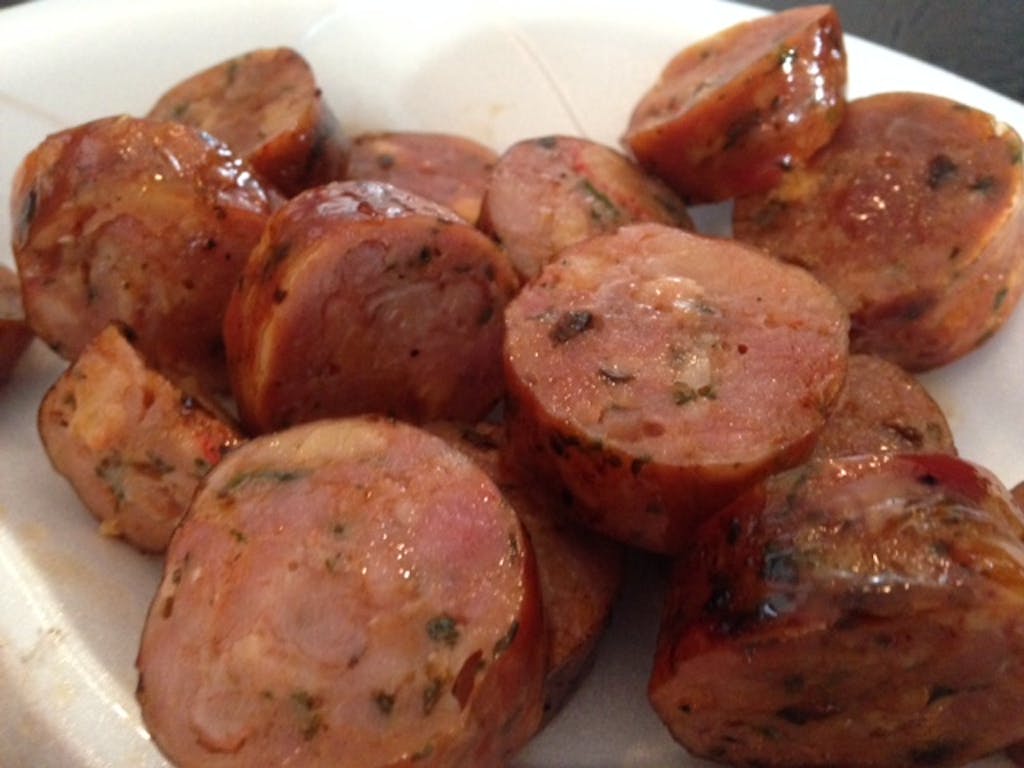
I don’t know if the Downey’s thought they had a real shot at the title (they finished outside the top 100). I’m not sure how you could have the focus you need for a barbecue competition after hosting two enormous parties on back-to-back nights. It was only 9:00, and I was ready for bed.

Saturday was the day of reckoning. That morning I spoke with first year Contestant Supervisor Anthony Compofelice about the competition rules. He provided me a copy of the 67-page HSLR rule book. Five of those pages discuss barbecue. The rest is dedicated to rules about sponsorship signage, egress, “Alcohol Management,” and port-a-lets. In the barbecue section, I learned the intricacies of the turn-in.
Every space in the vast parking lot of Reliant Stadium is sold to a team, and each spot allows for one meat entry. Each entrant must choose between brisket, pork ribs, or chicken to enter into Saturday’s competition. Teams can buy multiple spaces to give themselves more than one entry, but on Saturday every meat goes head-to-head. A good chicken can beat out ribs or even brisket for the top spot, and awards are still given out for the best of each category. Entrants seeking the best odds would have chosen chicken with only 89 entries compared to a 150 briskets and a 185 racks of ribs. Tuffy, along with the other three competitors, had the advantage of being able to turn in all three. They were in the Champions Corner which consisted of past champions of the HLSR, The Jack, the American Royal, and the Kingsford Invitational and the San Antonio Stock Show.
Those three entries were a blessing for their odds of winning, but a curse when it came to timing. At the HLSR, if your barbecue is one of the 24 best entries then you make it to the final table. An entrant then has to provide fresh entry in the same category. Not only did Tuffy have to juggle three proteins on competition day, but he also had to deal with a second version of each that was staggered back by roughly ninety minutes in hopes that it would make the final table. He already has a reputation from his friends on the circuit for putting as much stress into a turn-in box as meat, so the tension built throughout that Saturday morning. On the other side of the park, his BBQ Pitmasters cohorts Johnny Trigg and Rod Gray only had a few racks of ribs to worry about, and they showed no signs of worry.
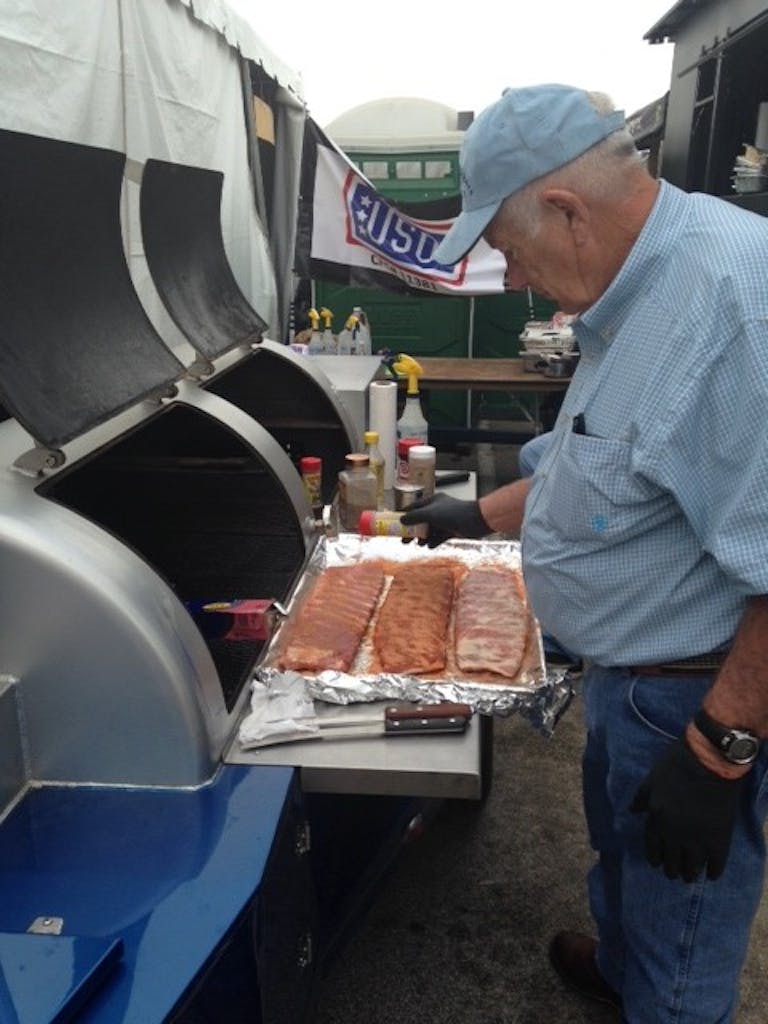
Rod Gray is a force in the KCBS and a former national barbecue champion. He hails from Kansas City, but decided to come down to Texas to help Alvarado native Johnny Trigg win in his home state. Johnny Trigg is not only the champion of BBQ Pitmaster Season 3, he is also a member of the KCBS Hall of Fame. When he was inducted in 2012 he received a heavy trophy with a bronze rack of ribs on top. The ribs were cast from a real rack prepared by Rod Gray.
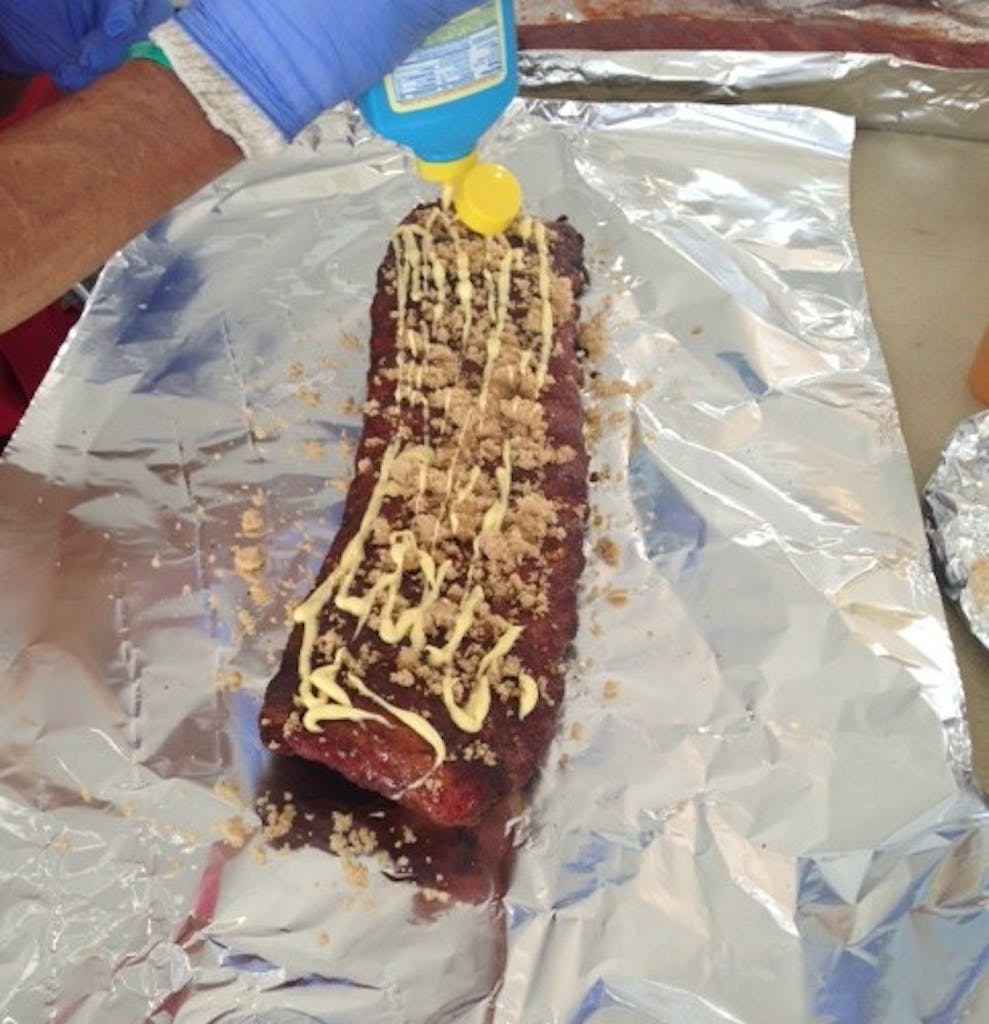
If the scene at Tuffy’s was controlled chaos, Trigg’s was more like lounging on the back deck, as long as your backyard has a Jambo pit. There wasn’t much room for doing anything else is this small piece of real estate carved out next to the USO tent that sponsored Trigg. Gray, the young gun who prefers to experiment a bit, and the stuck-in-his-ways veteran Trigg bickered like a married couple. Johnny wasn’t about to take any chances, and his recipe didn’t veer from the usual formula. I was sworn to secrecy on the entire line-up of products used for these famous St. Louis ribs, but there was plenty of aluminum foil, brown sugar, and blue plastic squeeze bottles of Parkay. I’m convinced that every bottle of the partially hydrogenated, trans-fat concoction that is Parkay is sold to barbecue competitors.
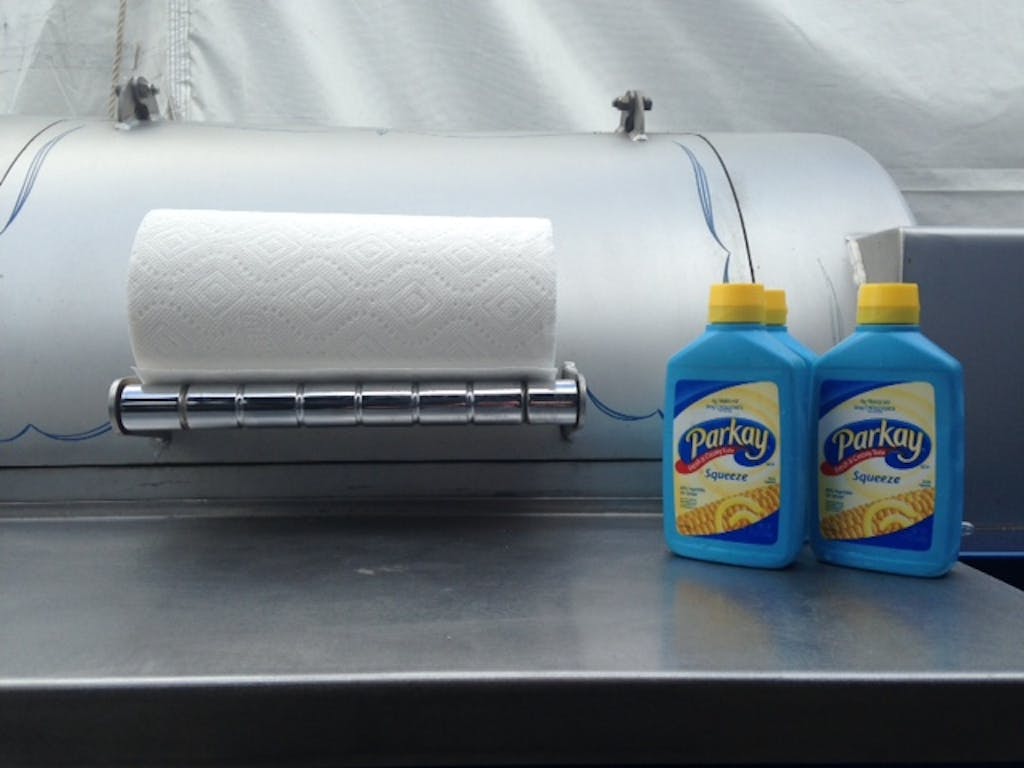
Just across Los Vaqueros Trail (all of the “streets” are named within the grounds) from Johnny Trigg was the BBQ Commanders tent. Inside, Jamie Geer was marinating his chicken. He once got a perfect score of 180 in chicken at the American Royal, so he had high hopes for his chances here in Houston. This time he had pulled back the skin of a whole split chicken to season it, and the halves were resting, impaled with toothpicks to reattach the skin. A thick lobe of skin kept the two halves connected and a metal tag that had been affixed by a Contestant Supervisor dangled in the gap. Barbecue contestants supply their own meat, and he metals tags are provided after the raw meat has been inspected and deemed to meet contest regulations. Before the meat can go into the turn-in box, an assigned Contestant Supervisor must confirm that the original tag is still intact. Only then can cutting and portioning proceed. If the tag is gone, then so are your chances for winning.
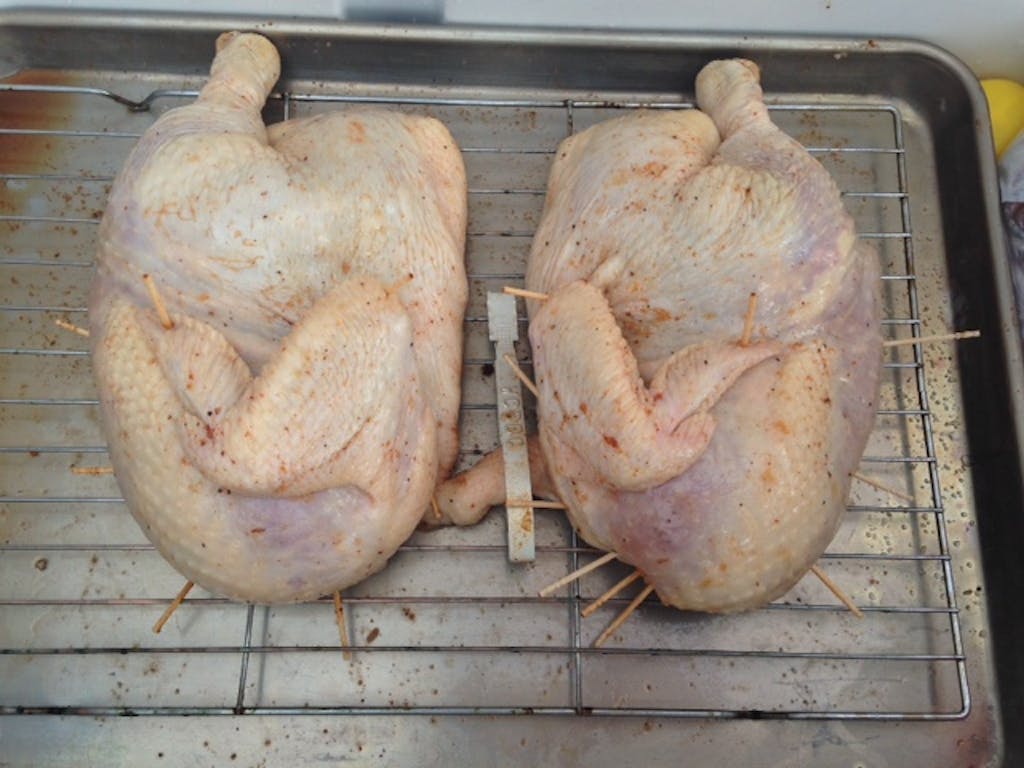
Jamie was even more laid back than Trigg. He was eager for me to try the new homemade sausage that he’d just developed for his barbecue joint Jambo’s Rib Shack in Rendon just south of Fort Worth. Potential customers for his popular Jambo Pits came by to negotiate prices and discuss fabrication timelines. The beauty of cooking chicken is that you only need a couple hours of smoking. The rest of the time you can use for selling smokers.

On the other side of the park I got an up close look at what $300,000 in sponsorships will get you. The Holy Cow Cookers tent looked like a permanent establishment. Inside there was a huge bar, a dance floor and stage, a bakery, coffee bar, and the cleanest bathrooms (port-a-lets) at the HLSR. Sponsor logos flashed across flat screen televisions (full disclosure: Texas Monthly was a sponsor). I declined one of the tempting root beer floats and walked over to the Committee tent. The judges’ meeting had just begun. We were getting close to turn-in time.
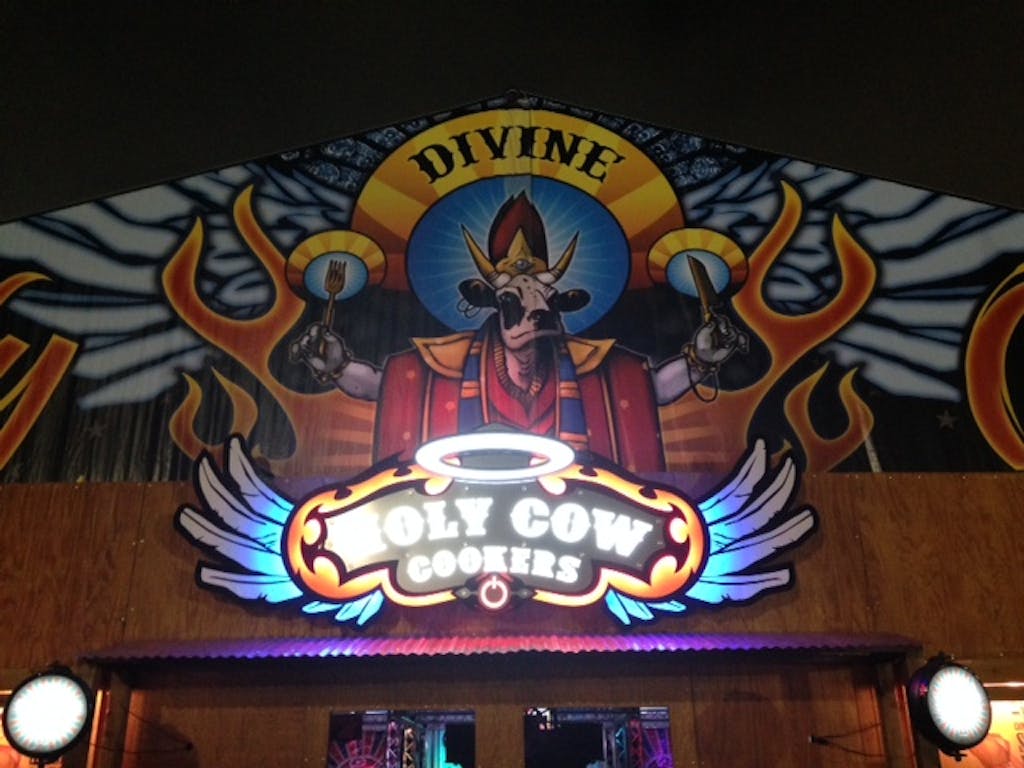
Back at Tuffy’s tent and entire barbecue brain trust has gathered to provide assistance as needed. Aaron Franklin of Franklin Barbecue in Austin and John Markus, creator of BBQ Pitmasters, were both armed with paper towels and foil ready to build the chicken box. The big sucker barely fit, but nothing that a little tape couldn’t help. I then guided Tuffy back to the Committee tent where he passed it across the table with a few minutes to spare.
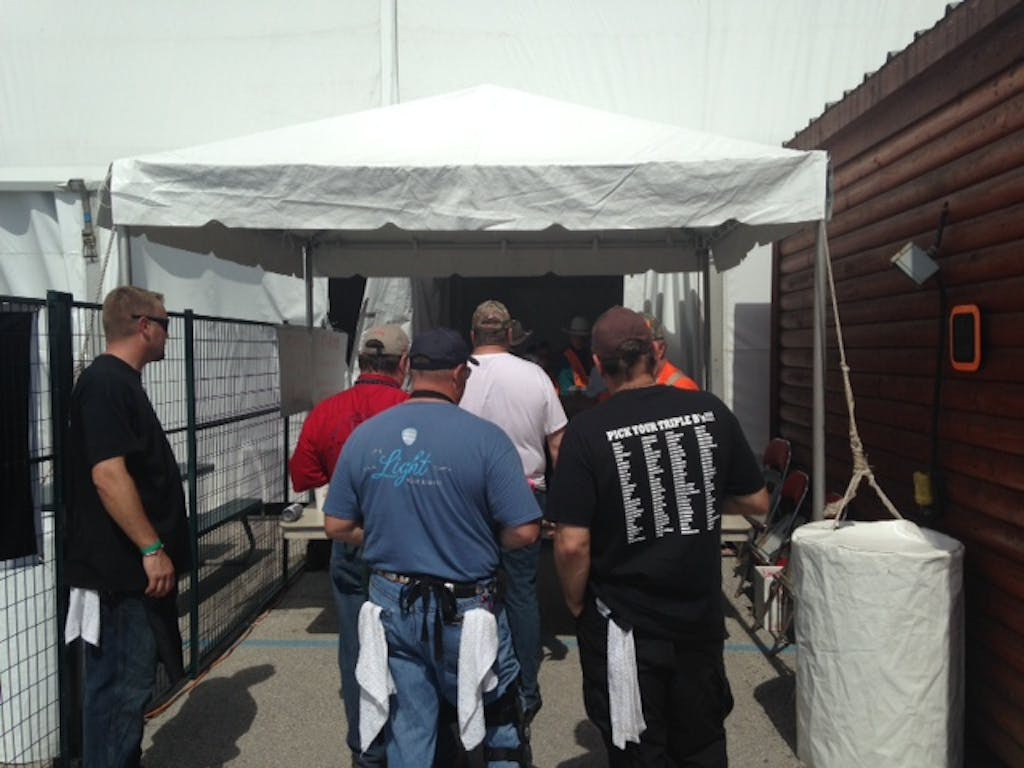
Back at the USO tent, Johnny Trigg was putting the finishing brush strokes on his three racks of ribs. He chose the best rack without second-guessing or any hesitation. He then built his competition box effortlessly. I’m convinced he could do it blindfolded.
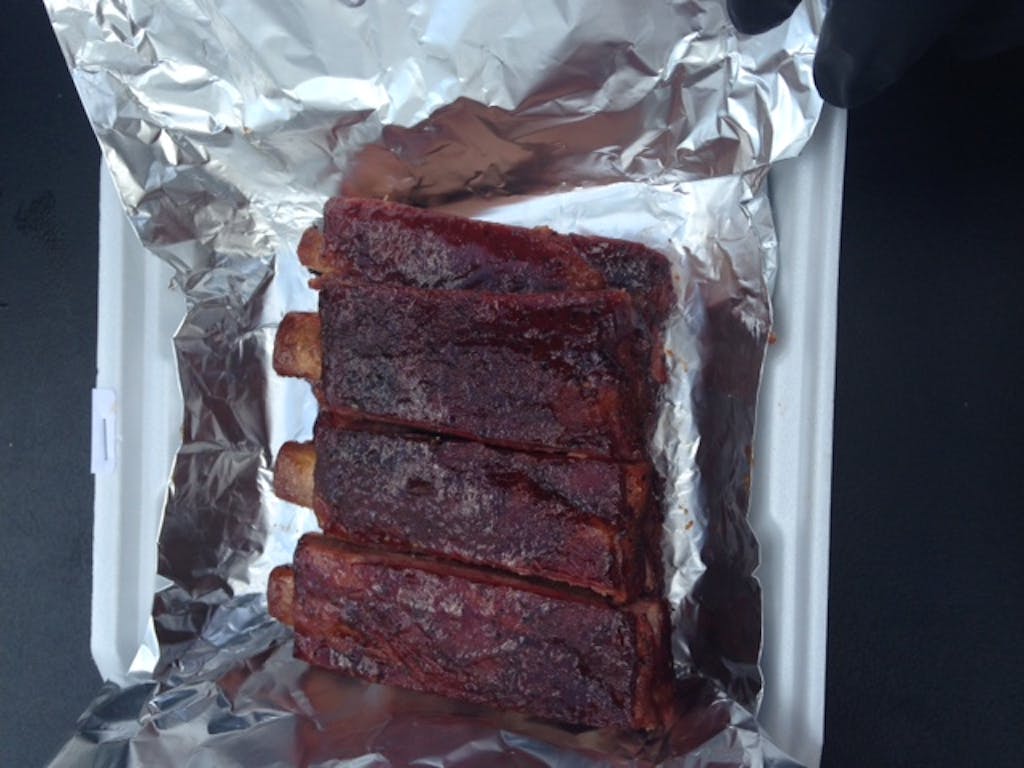
There were plenty of ribs to spare, so I had a snack. After poking fun at all that sugar and Parkay all weekend, I had to admit those ribs were pretty good. They weren’t good enough however to get Johnny to the final table, or even into the top 100. It just wasn’t his day.
To get some insight on a few other teams I followed Compofelice to a couple of the Go Texan county sponsored tents. Just before their chicken came off the smoker I told the Trinity County team good luck. “Good luck? If you need luck coming into this competition you’ve already lost” was the reply. Another team nearby was just pulling off their brisket. I watched as a completely untrimmed brisket was sliced thick, trimmed of fat and placed into a foil-lined Styrofoam box. I took a bite of a slice I was offered. It was undercooked and under seasoned. After hearing Tuffy wax poetic about his prime wagyu brisket from Snake River Farms, I asked this cook what kind of brisket he had cooked. There was a brief pause and a puzzled look. “Beef. It’s a beef brisket”
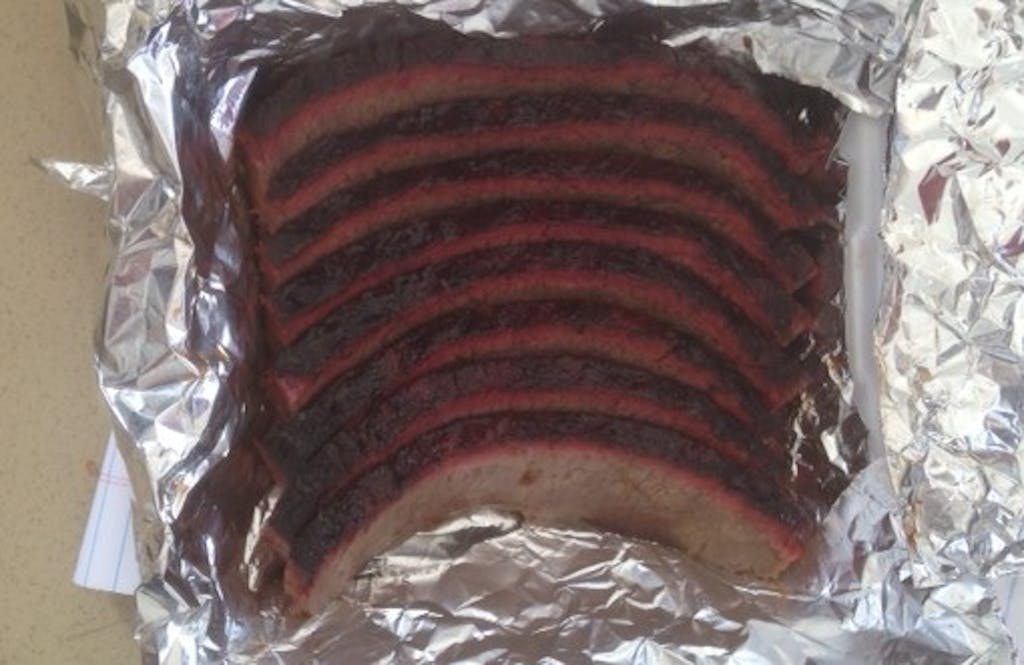
The wagyu brisket had just come off of Tuffy’s smoker when I returned. It didn’t look much like a Franklin brisket. Instead of a jet black crust, it was more mahogany after being wrapped for a good portion of cooking. All of the fat cap that usually covers the flat was shaved off before cooking. Tuffy cut eight meticulous slices from the flat, being careful to trim away most of the fat. Each slice was brushed with the reserved juices from the brisket, then it was all sprinkled with a fine powder of magic barbecue dust. The shaker’s contents were a secret, but let’s just say that in competition barbecue, if you ain’t using MSG, you ain’t trying. Now it was just time to wait.
I looked at all of these mops and seasonings and au jus as a bit of barbecue hocus pocus, but then again so does Tuffy Stone. He wouldn’t ever serve this stuff at one of his Cool Smoke restaurants because nobody would want a plate full of it. It’s just too intense. In these competitions he wants to cook to his perception of the judges’ taste, but still stay within a window that he can reconcile with his barbecue principles. He is a trained chef after all.
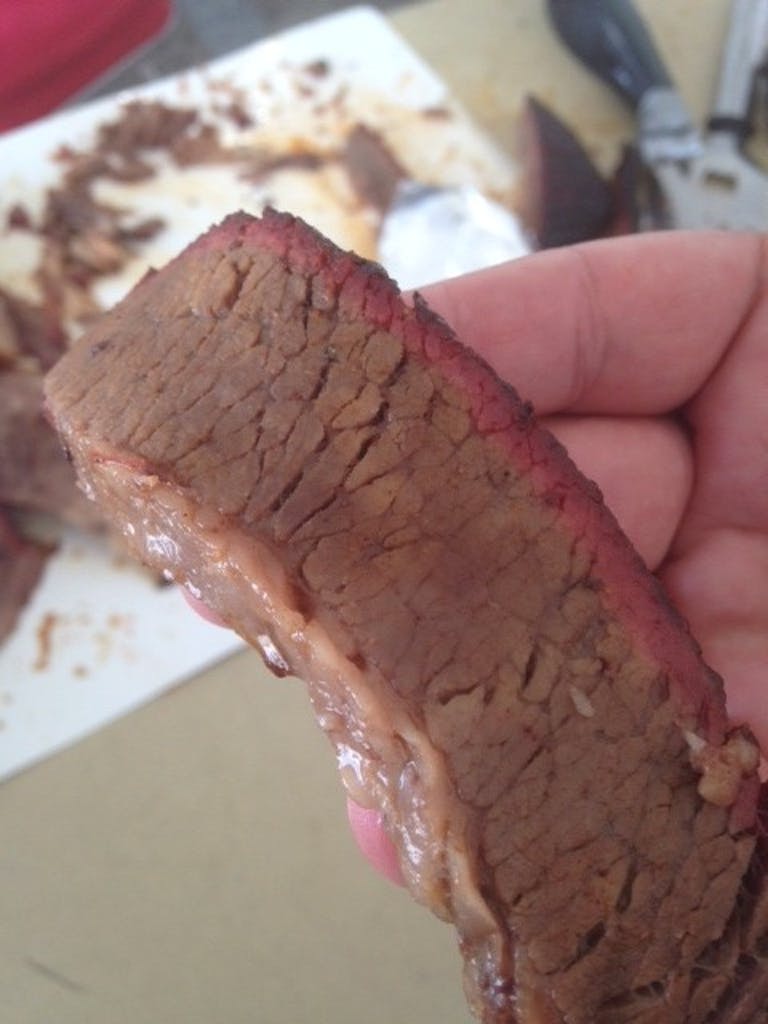
I took a slice of brisket from the flat that didn’t make it in the box. The initial flavors of salt and sugar were immediately pleasing, and the beefiness stood out. There wasn’t much smokiness to it, and I was really missing the moisture that a little fat cap would have provided. A chunk from the point end was much more moist, and the bark had a smokier flavor. After a few bites I realized I was actually enjoying it. I’ve judged a number of competitions, but this was the best competition barbecue brisket that I had eaten.
The call for the final table was scheduled for 4:30. Tuffy waited around until 5:30 before breathing that sigh of relief. His brisket had gotten him to the final table along with 23 other entries. One of those was Jamie Geer’s chicken. The second box of brisket was sent in and more waiting ensued. Just before 7:30 the final results were announced. Jamie Geer was the Grand Champion. Tuffy got second in brisket and third place overall. Chicken beat brisket, but it wasn’t a bad showing for a Virginia pork boy down here in Brisketville.








